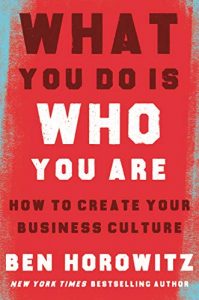
Author: Ben Horowitz
Rating: 9/10
Ben Horowitz’s new book is a great blend of storytelling, anecdotes, and examples on understanding, building, and eventually changing the culture of the organization. It’s an excellent and thoughtfully prepared read, that should be on the reading list of any founder/CEO.
Highlights
“Because who you are is how people talk about you when you’re not around. How do you treat your customers? Are you there for people in a pinch? Can you be trusted? Who you are is not the values you list on the wall. It’s not what you say at an all-hands. It’s not your marketing campaign. It’s not even what you believe. It’s what you do. What you do is who you are.”
“Without trust, communication breaks. Here’s why: In any human interaction, the required amount of communication is inversely proportional to the level of trust. If I trust you completely, then I require no explanation or communication of your actions at all, because I know that whatever you are doing is in my best interests. On the other hand, if I don’t trust you in the slightest, then no amount of talking, explaining, or reasoning will have any effect on me, because I will never believe you are telling me the truth and acting in my best interests.”
“There’s been a lot of research done on this that shows that most people’s brains can absorb new information several times faster and more effectively by reading information versus listening to it. Also, asking people to present their plans in written format forces them to express their ideas with a deeper level of detail.”
“Integrity, honesty, and decency are long-term cultural investments. Their purpose is not to make the quarter, beat a competitor, or attract a new employee. Their purpose is to create a better place to work and to make the company a better one to do business with in the long run.”
“He believed that you were either selling or being sold: if you weren’t selling a customer on your product then the customer was selling you on why she wasn’t going to buy it.”
“Your culture is how your company makes decisions when you’re not there. It’s the set of assumptions your employees use to resolve the problems they face every day. It’s how they behave when no one is looking. If you don’t methodically set your culture, then two-thirds of it will end up being accidental, and the rest will be a mistake.”
“Breakthrough ideas have traditionally been difficult to manage for two reasons: 1) innovative ideas fail far more than they succeed, and 2) innovative ideas are always controversial before they succeed. If everyone could instantly understand them, they wouldn’t be innovative.”
“Culture is not like a mission statement; you can’t just set it up and have it last forever. There’s a saying in the military that if you see something below standard and do nothing, then you’ve set a new standard. This is also true of culture—if you see something off-culture and ignore it, you’ve created a new culture.”
“Coaching, and not direction, is the first quality of leadership now. Get the barriers out of the way to let people do the things they do well.”
“Culture is to a company as nutrition and training are to an aspiring professional athlete. If the athlete is talented enough, he’ll succeed despite relatively poor nutrition and a below-average training regimen. If he lacks talent, perfect nutrition and relentless training will not qualify him for the Olympics. But great nutrition and training make every athlete better.”
“Here are the rules for writing a rule so powerful it sets the culture for many years: It must be memorable. If people forget the rule, they forget the culture. It must raise the question “Why?” Your rule should be so bizarre and shocking that everybody who hears it is compelled to ask, “Are you serious?” Its cultural impact must be straightforward. The answer to the “Why?” must clearly explain the cultural concept. People must encounter the rule almost daily. If your incredibly memorable rule applies only to situations people face once a year, it’s irrelevant.”
“The crucial four C’s. To sell, you had have 1) the competence—expert knowledge of the product you were selling and the process to demonstrate it (qualifying the buyer by validating their need and budget; helping define what their buying criteria are while setting traps for the competition; getting sign-off from the technical and the economic buyer at the customer, and so forth) so that you could have 2) the confidence to state your point of view, which would give you 3) the courage to have 4) the conviction not to be sold by the customer on why she wasn’t going to buy your product.”